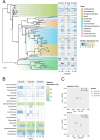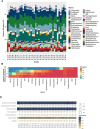Hidden Allies: Decoding the Core Endohyphal Bacteriome of Aspergillus fumigatus
- PMID: 40831189
- PMCID: PMC12365344
- DOI: 10.1111/1758-2229.70153
Hidden Allies: Decoding the Core Endohyphal Bacteriome of Aspergillus fumigatus
Abstract
Bacterial-fungal interactions that influence the behaviour of one or both organisms are common in nature. Well-studied systems include endosymbiotic relationships that range from transient to long-term associations. Diverse endohyphal bacteria associate with fungal hosts, emphasising the need to better comprehend the fungal bacteriome. We evaluated the hypothesis that Aspergillus fumigatus harbours an endohyphal community of bacteria that influence the host phenotype. We analysed whether 38 A. fumigatus strains show stable association with diverse endohyphal bacteria; all derived from single-conidium cultures that were subjected to antibiotic and heat treatments. The fungal bacteriome, inferred through analysis of bacterial diversity within the fungal strains (short- and long- read sequencing methods), revealed the presence of core endohyphal bacterial genera. Microscopic analysis further confirmed the presence of endohyphal bacteria. The fungal strains exhibited high genetic diversity and phenotypic heterogeneity in drug susceptibility and in vivo virulence. No correlations were observed between genomic or functional traits and bacteriome diversity, but the abundance of some bacterial genera correlated with fungal virulence or posaconazole susceptibility. The observed endobacteriome may play functional roles, for example, nitrogen fixation. Our study emphasises the existence of complex interactions between fungi and endohyphal bacteria, possibly impacting the phenotype of the fungal host, including virulence.
Keywords: Aspergillus fumigatus; clinical isolates; endohyphal bacteria; endosymbionts; fungal bacteriome; fungal virulence.
© 2025 The Author(s). Environmental Microbiology Reports published by John Wiley & Sons Ltd.
Conflict of interest statement
The authors declare no conflicts of interest.
Figures






Similar articles
-
Genomic insights reveal community structure and phylogenetic associations of endohyphal bacteria and viruses in fungal endophytes.Environ Microbiome. 2025 Jul 25;20(1):95. doi: 10.1186/s40793-025-00757-8. Environ Microbiome. 2025. PMID: 40713930 Free PMC article.
-
Triazole-resistant Aspergillus fumigatus in the Netherlands between 1994 and 2022: a genomic and phenotypic study.Lancet Microbe. 2025 Aug;6(8):101114. doi: 10.1016/j.lanmic.2025.101114. Epub 2025 Jul 9. Lancet Microbe. 2025. PMID: 40651492
-
Azole drugs have differential efficacy in varied models of immunosuppression in larval zebrafish hosts.Future Microbiol. 2025 Aug;20(12):793-806. doi: 10.1080/17460913.2025.2539639. Epub 2025 Aug 3. Future Microbiol. 2025. PMID: 40754843 Free PMC article.
-
Epidemiology of Triazole Resistant Aspergillus fumigatus in Asia: A Systematic Review and Meta-Analysis.Mycoses. 2025 Aug;68(8):e70099. doi: 10.1111/myc.70099. Mycoses. 2025. PMID: 40792442 Review.
-
Pharmacological interventions for those who have sexually offended or are at risk of offending.Cochrane Database Syst Rev. 2015 Feb 18;2015(2):CD007989. doi: 10.1002/14651858.CD007989.pub2. Cochrane Database Syst Rev. 2015. PMID: 25692326 Free PMC article.
References
-
- Abad, A. , Fernández‐Molina J. M., Bikandi J., et al. 2010. “What Makes a Successful Pathogen? Genes and Molecules Involved in Invasive Aspergillosis.” Revista Iberoamericana de Micología 27, no. 4: 155–182. - PubMed
-
- Araujo, D. , Mil‐Homens D., Henriques M., and Silva S.. 2022. “Anti‐EFG1 2'‐OMethylRNA Oligomer Inhibits <styled-content style="fixed-case"> Candida albicans </styled-content> Filamentation and Attenuates the Candidiasis in Galleria mellonella .” Molecular Therapy—Nucleic Acids 27: 517–523. - PMC - PubMed
MeSH terms
Grants and funding
- 2023ARA0025/U.S. Department of Energy, Office of Science, Biological and Environmental Research Division,
- LANLF59T/U.S. Department of Energy, Office of Science, Biological and Environmental Research Division,
- Project N. 007317/Programa Operacional Regional de Lisboa 2020
- PPBI-POCI-01-0145-FEDER-022122/European Regional Development Fund
- LA/P/0087/2020/Fundação para a Ciência e a Tecnologia
- LA/P/0140/2020/Fundação para a Ciência e a Tecnologia
- PD/BD/138913/2018/Fundação para a Ciência e a Tecnologia
- PTDC/CTA-AMB/6587/2020/Fundação para a Ciência e a Tecnologia
- UID/BIO/04565/2020/Fundação para a Ciência e a Tecnologia
- UIDB/04612/2020, UIDP/04612/2020/Fundação para a Ciência e a Tecnologia
LinkOut - more resources
Full Text Sources

